EDC2200 First Nations Education: Policies for Indigenous Australians
VerifiedAdded on 2022/10/17
|7
|2311
|15
Essay
AI Summary
This essay examines the policies developed by the Australian government concerning the education of Aboriginal and Torres Strait Islander peoples. It analyzes key policies such as the National Aboriginal and Torres Strait Islander Education Policy, the National Aboriginal and Torres Strait Islander Education Strategy 2015, and the Aboriginal and Torres Strait Islander Education Strategy 2017-2020. The essay highlights the historical context, aims, and principles of these policies, focusing on integrating indigenous perspectives, improving educational outcomes, and promoting cultural competency within the education system. It also discusses the importance of workforce development, student engagement, and the preservation of cultural identity. The essay concludes by emphasizing the government's commitment to ensuring quality education and equal opportunities for Indigenous Australians while acknowledging and respecting their unique cultural backgrounds.
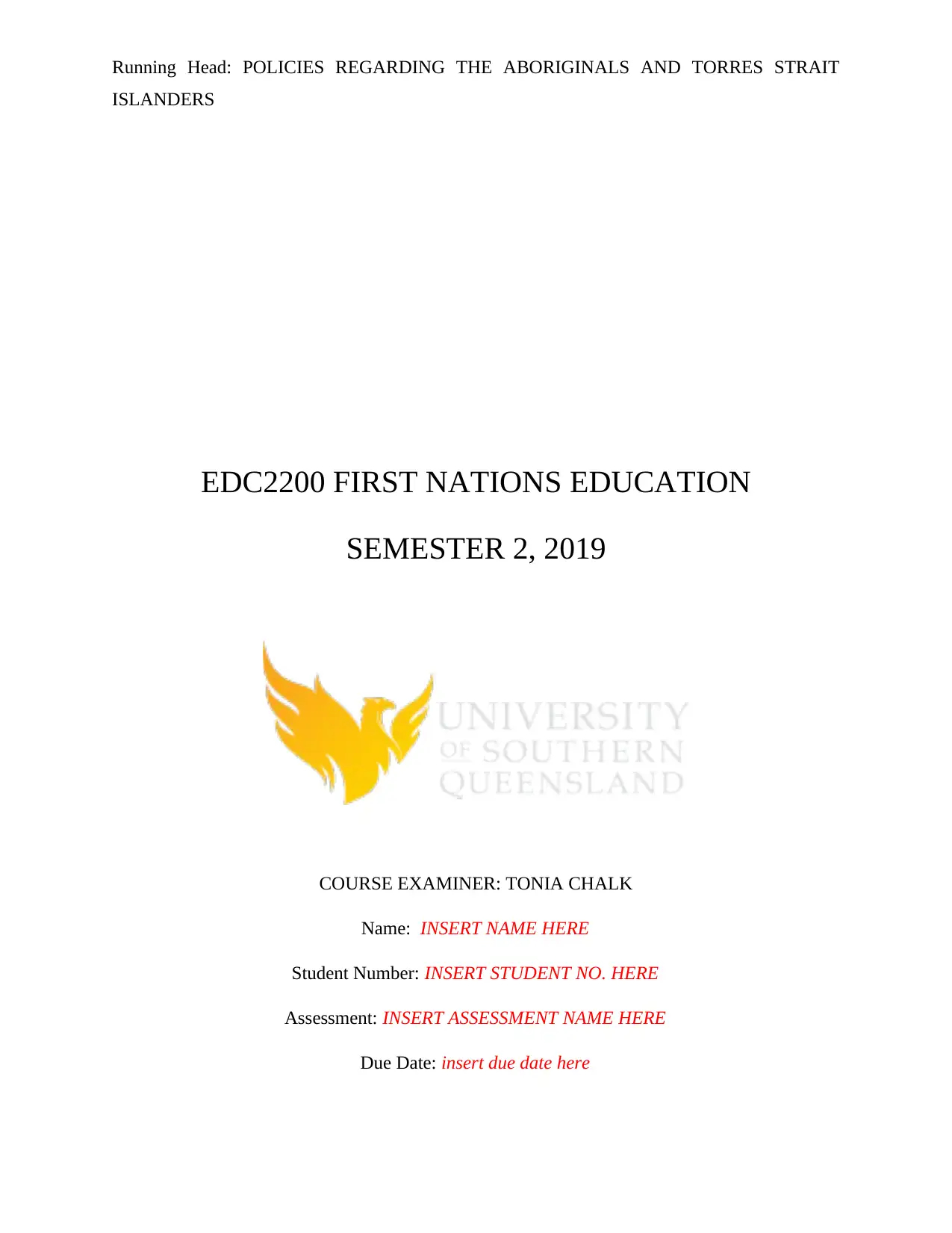
Running Head: POLICIES REGARDING THE ABORIGINALS AND TORRES STRAIT
ISLANDERS
EDC2200 FIRST NATIONS EDUCATION
SEMESTER 2, 2019
COURSE EXAMINER: TONIA CHALK
Name: INSERT NAME HERE
Student Number: INSERT STUDENT NO. HERE
Assessment: INSERT ASSESSMENT NAME HERE
Due Date: insert due date here
ISLANDERS
EDC2200 FIRST NATIONS EDUCATION
SEMESTER 2, 2019
COURSE EXAMINER: TONIA CHALK
Name: INSERT NAME HERE
Student Number: INSERT STUDENT NO. HERE
Assessment: INSERT ASSESSMENT NAME HERE
Due Date: insert due date here
Paraphrase This Document
Need a fresh take? Get an instant paraphrase of this document with our AI Paraphraser
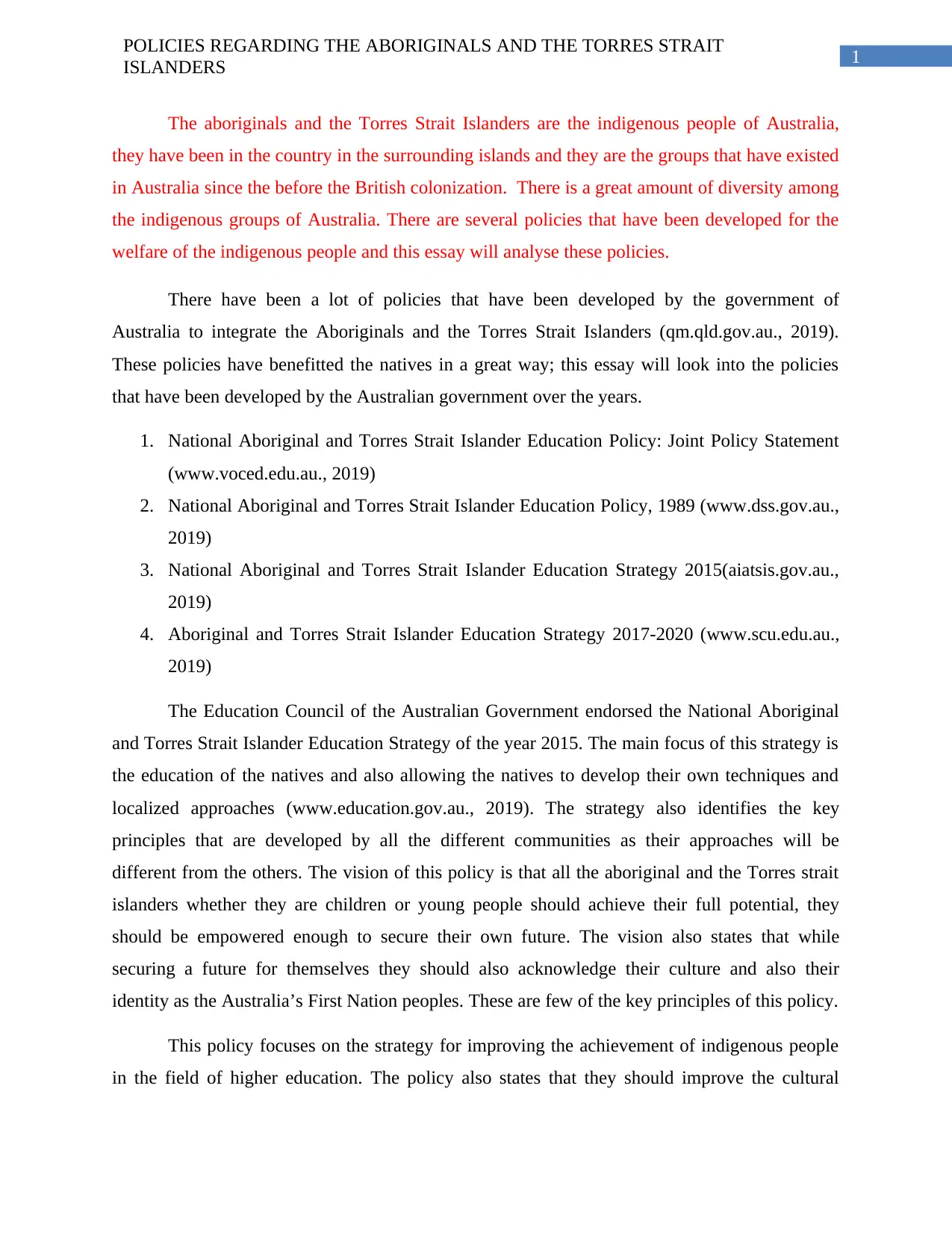
1
POLICIES REGARDING THE ABORIGINALS AND THE TORRES STRAIT
ISLANDERS
The aboriginals and the Torres Strait Islanders are the indigenous people of Australia,
they have been in the country in the surrounding islands and they are the groups that have existed
in Australia since the before the British colonization. There is a great amount of diversity among
the indigenous groups of Australia. There are several policies that have been developed for the
welfare of the indigenous people and this essay will analyse these policies.
There have been a lot of policies that have been developed by the government of
Australia to integrate the Aboriginals and the Torres Strait Islanders (qm.qld.gov.au., 2019).
These policies have benefitted the natives in a great way; this essay will look into the policies
that have been developed by the Australian government over the years.
1. National Aboriginal and Torres Strait Islander Education Policy: Joint Policy Statement
(www.voced.edu.au., 2019)
2. National Aboriginal and Torres Strait Islander Education Policy, 1989 (www.dss.gov.au.,
2019)
3. National Aboriginal and Torres Strait Islander Education Strategy 2015(aiatsis.gov.au.,
2019)
4. Aboriginal and Torres Strait Islander Education Strategy 2017-2020 (www.scu.edu.au.,
2019)
The Education Council of the Australian Government endorsed the National Aboriginal
and Torres Strait Islander Education Strategy of the year 2015. The main focus of this strategy is
the education of the natives and also allowing the natives to develop their own techniques and
localized approaches (www.education.gov.au., 2019). The strategy also identifies the key
principles that are developed by all the different communities as their approaches will be
different from the others. The vision of this policy is that all the aboriginal and the Torres strait
islanders whether they are children or young people should achieve their full potential, they
should be empowered enough to secure their own future. The vision also states that while
securing a future for themselves they should also acknowledge their culture and also their
identity as the Australia’s First Nation peoples. These are few of the key principles of this policy.
This policy focuses on the strategy for improving the achievement of indigenous people
in the field of higher education. The policy also states that they should improve the cultural
POLICIES REGARDING THE ABORIGINALS AND THE TORRES STRAIT
ISLANDERS
The aboriginals and the Torres Strait Islanders are the indigenous people of Australia,
they have been in the country in the surrounding islands and they are the groups that have existed
in Australia since the before the British colonization. There is a great amount of diversity among
the indigenous groups of Australia. There are several policies that have been developed for the
welfare of the indigenous people and this essay will analyse these policies.
There have been a lot of policies that have been developed by the government of
Australia to integrate the Aboriginals and the Torres Strait Islanders (qm.qld.gov.au., 2019).
These policies have benefitted the natives in a great way; this essay will look into the policies
that have been developed by the Australian government over the years.
1. National Aboriginal and Torres Strait Islander Education Policy: Joint Policy Statement
(www.voced.edu.au., 2019)
2. National Aboriginal and Torres Strait Islander Education Policy, 1989 (www.dss.gov.au.,
2019)
3. National Aboriginal and Torres Strait Islander Education Strategy 2015(aiatsis.gov.au.,
2019)
4. Aboriginal and Torres Strait Islander Education Strategy 2017-2020 (www.scu.edu.au.,
2019)
The Education Council of the Australian Government endorsed the National Aboriginal
and Torres Strait Islander Education Strategy of the year 2015. The main focus of this strategy is
the education of the natives and also allowing the natives to develop their own techniques and
localized approaches (www.education.gov.au., 2019). The strategy also identifies the key
principles that are developed by all the different communities as their approaches will be
different from the others. The vision of this policy is that all the aboriginal and the Torres strait
islanders whether they are children or young people should achieve their full potential, they
should be empowered enough to secure their own future. The vision also states that while
securing a future for themselves they should also acknowledge their culture and also their
identity as the Australia’s First Nation peoples. These are few of the key principles of this policy.
This policy focuses on the strategy for improving the achievement of indigenous people
in the field of higher education. The policy also states that they should improve the cultural
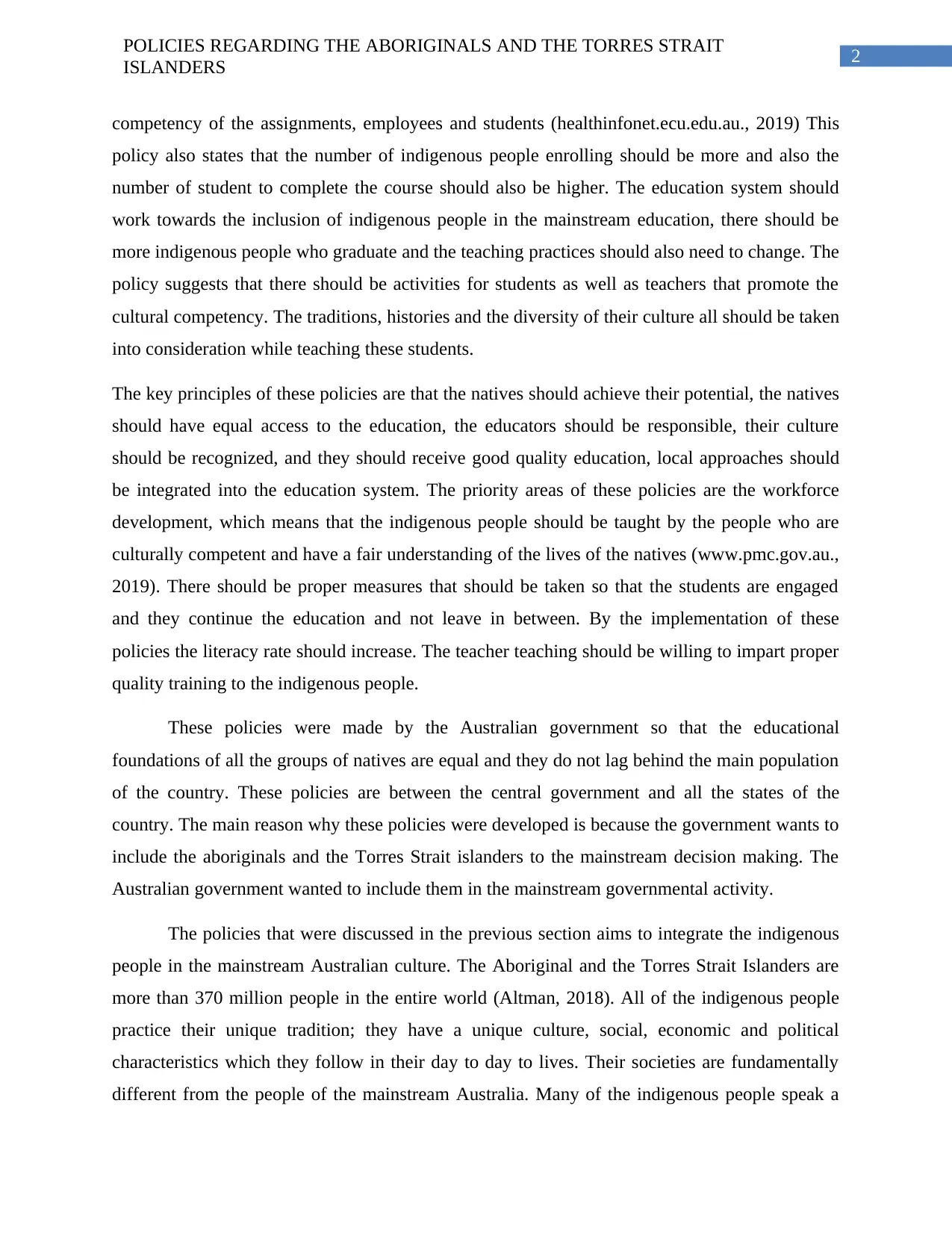
2
POLICIES REGARDING THE ABORIGINALS AND THE TORRES STRAIT
ISLANDERS
competency of the assignments, employees and students (healthinfonet.ecu.edu.au., 2019) This
policy also states that the number of indigenous people enrolling should be more and also the
number of student to complete the course should also be higher. The education system should
work towards the inclusion of indigenous people in the mainstream education, there should be
more indigenous people who graduate and the teaching practices should also need to change. The
policy suggests that there should be activities for students as well as teachers that promote the
cultural competency. The traditions, histories and the diversity of their culture all should be taken
into consideration while teaching these students.
The key principles of these policies are that the natives should achieve their potential, the natives
should have equal access to the education, the educators should be responsible, their culture
should be recognized, and they should receive good quality education, local approaches should
be integrated into the education system. The priority areas of these policies are the workforce
development, which means that the indigenous people should be taught by the people who are
culturally competent and have a fair understanding of the lives of the natives (www.pmc.gov.au.,
2019). There should be proper measures that should be taken so that the students are engaged
and they continue the education and not leave in between. By the implementation of these
policies the literacy rate should increase. The teacher teaching should be willing to impart proper
quality training to the indigenous people.
These policies were made by the Australian government so that the educational
foundations of all the groups of natives are equal and they do not lag behind the main population
of the country. These policies are between the central government and all the states of the
country. The main reason why these policies were developed is because the government wants to
include the aboriginals and the Torres Strait islanders to the mainstream decision making. The
Australian government wanted to include them in the mainstream governmental activity.
The policies that were discussed in the previous section aims to integrate the indigenous
people in the mainstream Australian culture. The Aboriginal and the Torres Strait Islanders are
more than 370 million people in the entire world (Altman, 2018). All of the indigenous people
practice their unique tradition; they have a unique culture, social, economic and political
characteristics which they follow in their day to day to lives. Their societies are fundamentally
different from the people of the mainstream Australia. Many of the indigenous people speak a
POLICIES REGARDING THE ABORIGINALS AND THE TORRES STRAIT
ISLANDERS
competency of the assignments, employees and students (healthinfonet.ecu.edu.au., 2019) This
policy also states that the number of indigenous people enrolling should be more and also the
number of student to complete the course should also be higher. The education system should
work towards the inclusion of indigenous people in the mainstream education, there should be
more indigenous people who graduate and the teaching practices should also need to change. The
policy suggests that there should be activities for students as well as teachers that promote the
cultural competency. The traditions, histories and the diversity of their culture all should be taken
into consideration while teaching these students.
The key principles of these policies are that the natives should achieve their potential, the natives
should have equal access to the education, the educators should be responsible, their culture
should be recognized, and they should receive good quality education, local approaches should
be integrated into the education system. The priority areas of these policies are the workforce
development, which means that the indigenous people should be taught by the people who are
culturally competent and have a fair understanding of the lives of the natives (www.pmc.gov.au.,
2019). There should be proper measures that should be taken so that the students are engaged
and they continue the education and not leave in between. By the implementation of these
policies the literacy rate should increase. The teacher teaching should be willing to impart proper
quality training to the indigenous people.
These policies were made by the Australian government so that the educational
foundations of all the groups of natives are equal and they do not lag behind the main population
of the country. These policies are between the central government and all the states of the
country. The main reason why these policies were developed is because the government wants to
include the aboriginals and the Torres Strait islanders to the mainstream decision making. The
Australian government wanted to include them in the mainstream governmental activity.
The policies that were discussed in the previous section aims to integrate the indigenous
people in the mainstream Australian culture. The Aboriginal and the Torres Strait Islanders are
more than 370 million people in the entire world (Altman, 2018). All of the indigenous people
practice their unique tradition; they have a unique culture, social, economic and political
characteristics which they follow in their day to day to lives. Their societies are fundamentally
different from the people of the mainstream Australia. Many of the indigenous people speak a
⊘ This is a preview!⊘
Do you want full access?
Subscribe today to unlock all pages.

Trusted by 1+ million students worldwide
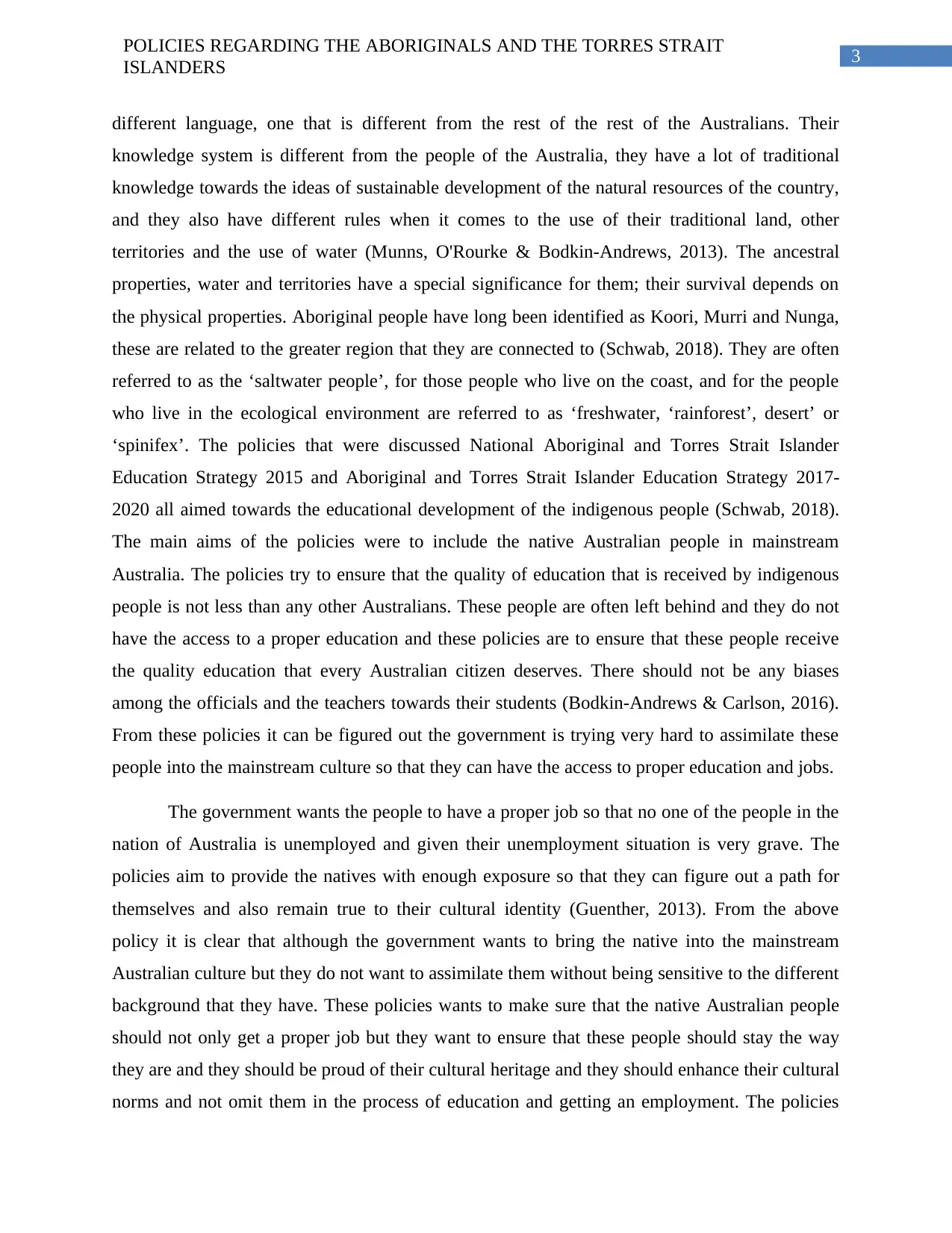
3
POLICIES REGARDING THE ABORIGINALS AND THE TORRES STRAIT
ISLANDERS
different language, one that is different from the rest of the rest of the Australians. Their
knowledge system is different from the people of the Australia, they have a lot of traditional
knowledge towards the ideas of sustainable development of the natural resources of the country,
and they also have different rules when it comes to the use of their traditional land, other
territories and the use of water (Munns, O'Rourke & Bodkin-Andrews, 2013). The ancestral
properties, water and territories have a special significance for them; their survival depends on
the physical properties. Aboriginal people have long been identified as Koori, Murri and Nunga,
these are related to the greater region that they are connected to (Schwab, 2018). They are often
referred to as the ‘saltwater people’, for those people who live on the coast, and for the people
who live in the ecological environment are referred to as ‘freshwater, ‘rainforest’, desert’ or
‘spinifex’. The policies that were discussed National Aboriginal and Torres Strait Islander
Education Strategy 2015 and Aboriginal and Torres Strait Islander Education Strategy 2017-
2020 all aimed towards the educational development of the indigenous people (Schwab, 2018).
The main aims of the policies were to include the native Australian people in mainstream
Australia. The policies try to ensure that the quality of education that is received by indigenous
people is not less than any other Australians. These people are often left behind and they do not
have the access to a proper education and these policies are to ensure that these people receive
the quality education that every Australian citizen deserves. There should not be any biases
among the officials and the teachers towards their students (Bodkin-Andrews & Carlson, 2016).
From these policies it can be figured out the government is trying very hard to assimilate these
people into the mainstream culture so that they can have the access to proper education and jobs.
The government wants the people to have a proper job so that no one of the people in the
nation of Australia is unemployed and given their unemployment situation is very grave. The
policies aim to provide the natives with enough exposure so that they can figure out a path for
themselves and also remain true to their cultural identity (Guenther, 2013). From the above
policy it is clear that although the government wants to bring the native into the mainstream
Australian culture but they do not want to assimilate them without being sensitive to the different
background that they have. These policies wants to make sure that the native Australian people
should not only get a proper job but they want to ensure that these people should stay the way
they are and they should be proud of their cultural heritage and they should enhance their cultural
norms and not omit them in the process of education and getting an employment. The policies
POLICIES REGARDING THE ABORIGINALS AND THE TORRES STRAIT
ISLANDERS
different language, one that is different from the rest of the rest of the Australians. Their
knowledge system is different from the people of the Australia, they have a lot of traditional
knowledge towards the ideas of sustainable development of the natural resources of the country,
and they also have different rules when it comes to the use of their traditional land, other
territories and the use of water (Munns, O'Rourke & Bodkin-Andrews, 2013). The ancestral
properties, water and territories have a special significance for them; their survival depends on
the physical properties. Aboriginal people have long been identified as Koori, Murri and Nunga,
these are related to the greater region that they are connected to (Schwab, 2018). They are often
referred to as the ‘saltwater people’, for those people who live on the coast, and for the people
who live in the ecological environment are referred to as ‘freshwater, ‘rainforest’, desert’ or
‘spinifex’. The policies that were discussed National Aboriginal and Torres Strait Islander
Education Strategy 2015 and Aboriginal and Torres Strait Islander Education Strategy 2017-
2020 all aimed towards the educational development of the indigenous people (Schwab, 2018).
The main aims of the policies were to include the native Australian people in mainstream
Australia. The policies try to ensure that the quality of education that is received by indigenous
people is not less than any other Australians. These people are often left behind and they do not
have the access to a proper education and these policies are to ensure that these people receive
the quality education that every Australian citizen deserves. There should not be any biases
among the officials and the teachers towards their students (Bodkin-Andrews & Carlson, 2016).
From these policies it can be figured out the government is trying very hard to assimilate these
people into the mainstream culture so that they can have the access to proper education and jobs.
The government wants the people to have a proper job so that no one of the people in the
nation of Australia is unemployed and given their unemployment situation is very grave. The
policies aim to provide the natives with enough exposure so that they can figure out a path for
themselves and also remain true to their cultural identity (Guenther, 2013). From the above
policy it is clear that although the government wants to bring the native into the mainstream
Australian culture but they do not want to assimilate them without being sensitive to the different
background that they have. These policies wants to make sure that the native Australian people
should not only get a proper job but they want to ensure that these people should stay the way
they are and they should be proud of their cultural heritage and they should enhance their cultural
norms and not omit them in the process of education and getting an employment. The policies
Paraphrase This Document
Need a fresh take? Get an instant paraphrase of this document with our AI Paraphraser
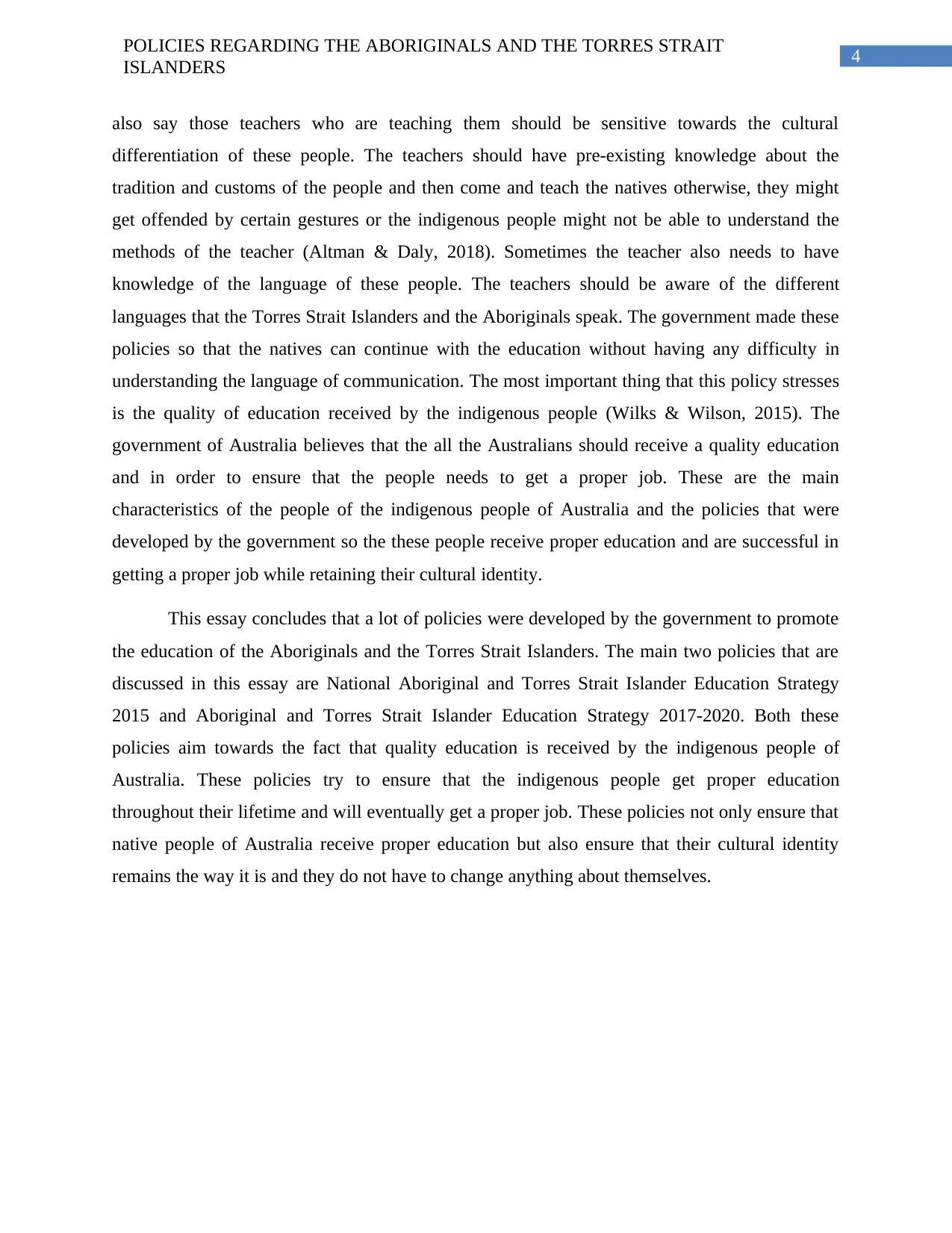
4
POLICIES REGARDING THE ABORIGINALS AND THE TORRES STRAIT
ISLANDERS
also say those teachers who are teaching them should be sensitive towards the cultural
differentiation of these people. The teachers should have pre-existing knowledge about the
tradition and customs of the people and then come and teach the natives otherwise, they might
get offended by certain gestures or the indigenous people might not be able to understand the
methods of the teacher (Altman & Daly, 2018). Sometimes the teacher also needs to have
knowledge of the language of these people. The teachers should be aware of the different
languages that the Torres Strait Islanders and the Aboriginals speak. The government made these
policies so that the natives can continue with the education without having any difficulty in
understanding the language of communication. The most important thing that this policy stresses
is the quality of education received by the indigenous people (Wilks & Wilson, 2015). The
government of Australia believes that the all the Australians should receive a quality education
and in order to ensure that the people needs to get a proper job. These are the main
characteristics of the people of the indigenous people of Australia and the policies that were
developed by the government so the these people receive proper education and are successful in
getting a proper job while retaining their cultural identity.
This essay concludes that a lot of policies were developed by the government to promote
the education of the Aboriginals and the Torres Strait Islanders. The main two policies that are
discussed in this essay are National Aboriginal and Torres Strait Islander Education Strategy
2015 and Aboriginal and Torres Strait Islander Education Strategy 2017-2020. Both these
policies aim towards the fact that quality education is received by the indigenous people of
Australia. These policies try to ensure that the indigenous people get proper education
throughout their lifetime and will eventually get a proper job. These policies not only ensure that
native people of Australia receive proper education but also ensure that their cultural identity
remains the way it is and they do not have to change anything about themselves.
POLICIES REGARDING THE ABORIGINALS AND THE TORRES STRAIT
ISLANDERS
also say those teachers who are teaching them should be sensitive towards the cultural
differentiation of these people. The teachers should have pre-existing knowledge about the
tradition and customs of the people and then come and teach the natives otherwise, they might
get offended by certain gestures or the indigenous people might not be able to understand the
methods of the teacher (Altman & Daly, 2018). Sometimes the teacher also needs to have
knowledge of the language of these people. The teachers should be aware of the different
languages that the Torres Strait Islanders and the Aboriginals speak. The government made these
policies so that the natives can continue with the education without having any difficulty in
understanding the language of communication. The most important thing that this policy stresses
is the quality of education received by the indigenous people (Wilks & Wilson, 2015). The
government of Australia believes that the all the Australians should receive a quality education
and in order to ensure that the people needs to get a proper job. These are the main
characteristics of the people of the indigenous people of Australia and the policies that were
developed by the government so the these people receive proper education and are successful in
getting a proper job while retaining their cultural identity.
This essay concludes that a lot of policies were developed by the government to promote
the education of the Aboriginals and the Torres Strait Islanders. The main two policies that are
discussed in this essay are National Aboriginal and Torres Strait Islander Education Strategy
2015 and Aboriginal and Torres Strait Islander Education Strategy 2017-2020. Both these
policies aim towards the fact that quality education is received by the indigenous people of
Australia. These policies try to ensure that the indigenous people get proper education
throughout their lifetime and will eventually get a proper job. These policies not only ensure that
native people of Australia receive proper education but also ensure that their cultural identity
remains the way it is and they do not have to change anything about themselves.
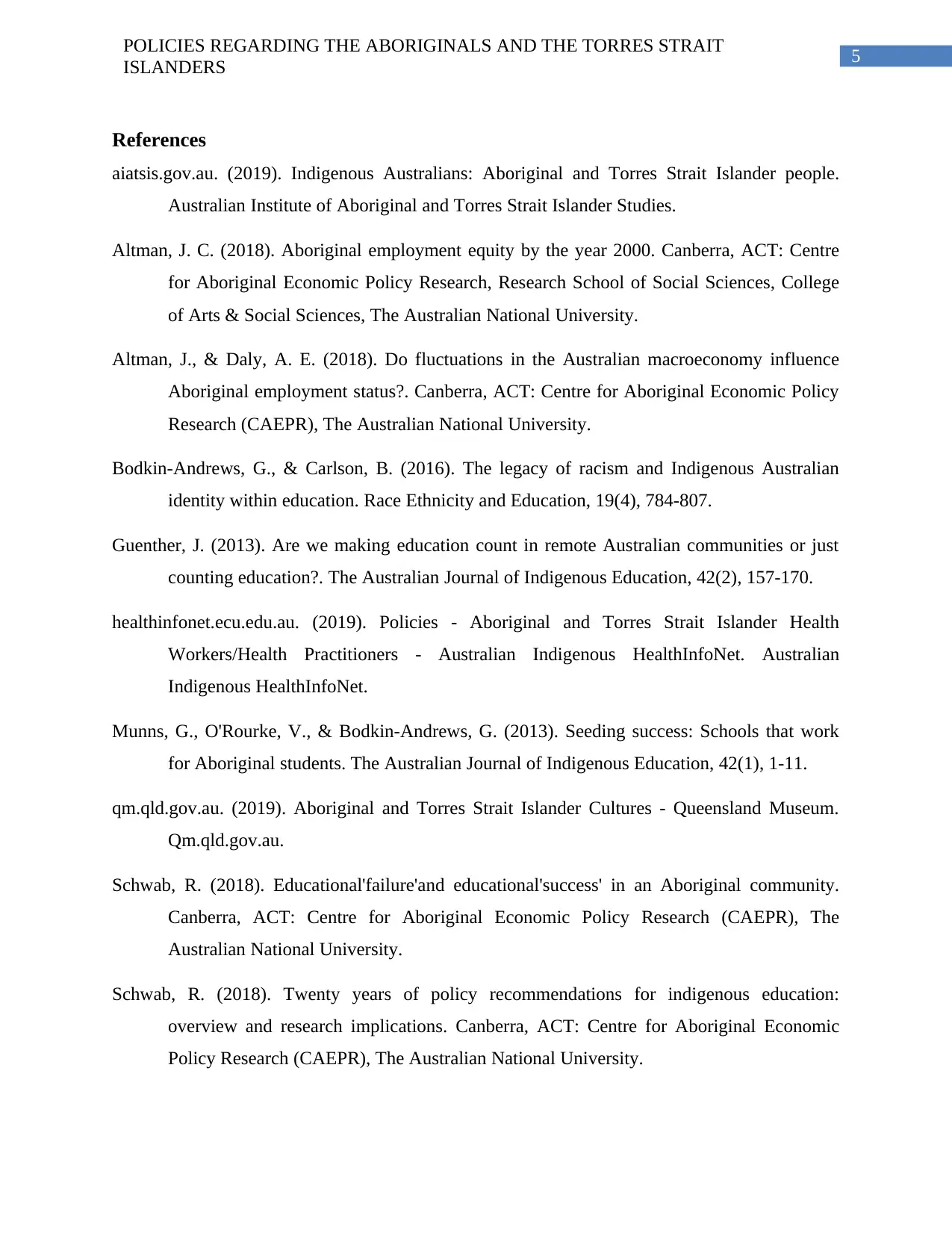
5
POLICIES REGARDING THE ABORIGINALS AND THE TORRES STRAIT
ISLANDERS
References
aiatsis.gov.au. (2019). Indigenous Australians: Aboriginal and Torres Strait Islander people.
Australian Institute of Aboriginal and Torres Strait Islander Studies.
Altman, J. C. (2018). Aboriginal employment equity by the year 2000. Canberra, ACT: Centre
for Aboriginal Economic Policy Research, Research School of Social Sciences, College
of Arts & Social Sciences, The Australian National University.
Altman, J., & Daly, A. E. (2018). Do fluctuations in the Australian macroeconomy influence
Aboriginal employment status?. Canberra, ACT: Centre for Aboriginal Economic Policy
Research (CAEPR), The Australian National University.
Bodkin-Andrews, G., & Carlson, B. (2016). The legacy of racism and Indigenous Australian
identity within education. Race Ethnicity and Education, 19(4), 784-807.
Guenther, J. (2013). Are we making education count in remote Australian communities or just
counting education?. The Australian Journal of Indigenous Education, 42(2), 157-170.
healthinfonet.ecu.edu.au. (2019). Policies - Aboriginal and Torres Strait Islander Health
Workers/Health Practitioners - Australian Indigenous HealthInfoNet. Australian
Indigenous HealthInfoNet.
Munns, G., O'Rourke, V., & Bodkin-Andrews, G. (2013). Seeding success: Schools that work
for Aboriginal students. The Australian Journal of Indigenous Education, 42(1), 1-11.
qm.qld.gov.au. (2019). Aboriginal and Torres Strait Islander Cultures - Queensland Museum.
Qm.qld.gov.au.
Schwab, R. (2018). Educational'failure'and educational'success' in an Aboriginal community.
Canberra, ACT: Centre for Aboriginal Economic Policy Research (CAEPR), The
Australian National University.
Schwab, R. (2018). Twenty years of policy recommendations for indigenous education:
overview and research implications. Canberra, ACT: Centre for Aboriginal Economic
Policy Research (CAEPR), The Australian National University.
POLICIES REGARDING THE ABORIGINALS AND THE TORRES STRAIT
ISLANDERS
References
aiatsis.gov.au. (2019). Indigenous Australians: Aboriginal and Torres Strait Islander people.
Australian Institute of Aboriginal and Torres Strait Islander Studies.
Altman, J. C. (2018). Aboriginal employment equity by the year 2000. Canberra, ACT: Centre
for Aboriginal Economic Policy Research, Research School of Social Sciences, College
of Arts & Social Sciences, The Australian National University.
Altman, J., & Daly, A. E. (2018). Do fluctuations in the Australian macroeconomy influence
Aboriginal employment status?. Canberra, ACT: Centre for Aboriginal Economic Policy
Research (CAEPR), The Australian National University.
Bodkin-Andrews, G., & Carlson, B. (2016). The legacy of racism and Indigenous Australian
identity within education. Race Ethnicity and Education, 19(4), 784-807.
Guenther, J. (2013). Are we making education count in remote Australian communities or just
counting education?. The Australian Journal of Indigenous Education, 42(2), 157-170.
healthinfonet.ecu.edu.au. (2019). Policies - Aboriginal and Torres Strait Islander Health
Workers/Health Practitioners - Australian Indigenous HealthInfoNet. Australian
Indigenous HealthInfoNet.
Munns, G., O'Rourke, V., & Bodkin-Andrews, G. (2013). Seeding success: Schools that work
for Aboriginal students. The Australian Journal of Indigenous Education, 42(1), 1-11.
qm.qld.gov.au. (2019). Aboriginal and Torres Strait Islander Cultures - Queensland Museum.
Qm.qld.gov.au.
Schwab, R. (2018). Educational'failure'and educational'success' in an Aboriginal community.
Canberra, ACT: Centre for Aboriginal Economic Policy Research (CAEPR), The
Australian National University.
Schwab, R. (2018). Twenty years of policy recommendations for indigenous education:
overview and research implications. Canberra, ACT: Centre for Aboriginal Economic
Policy Research (CAEPR), The Australian National University.
⊘ This is a preview!⊘
Do you want full access?
Subscribe today to unlock all pages.

Trusted by 1+ million students worldwide
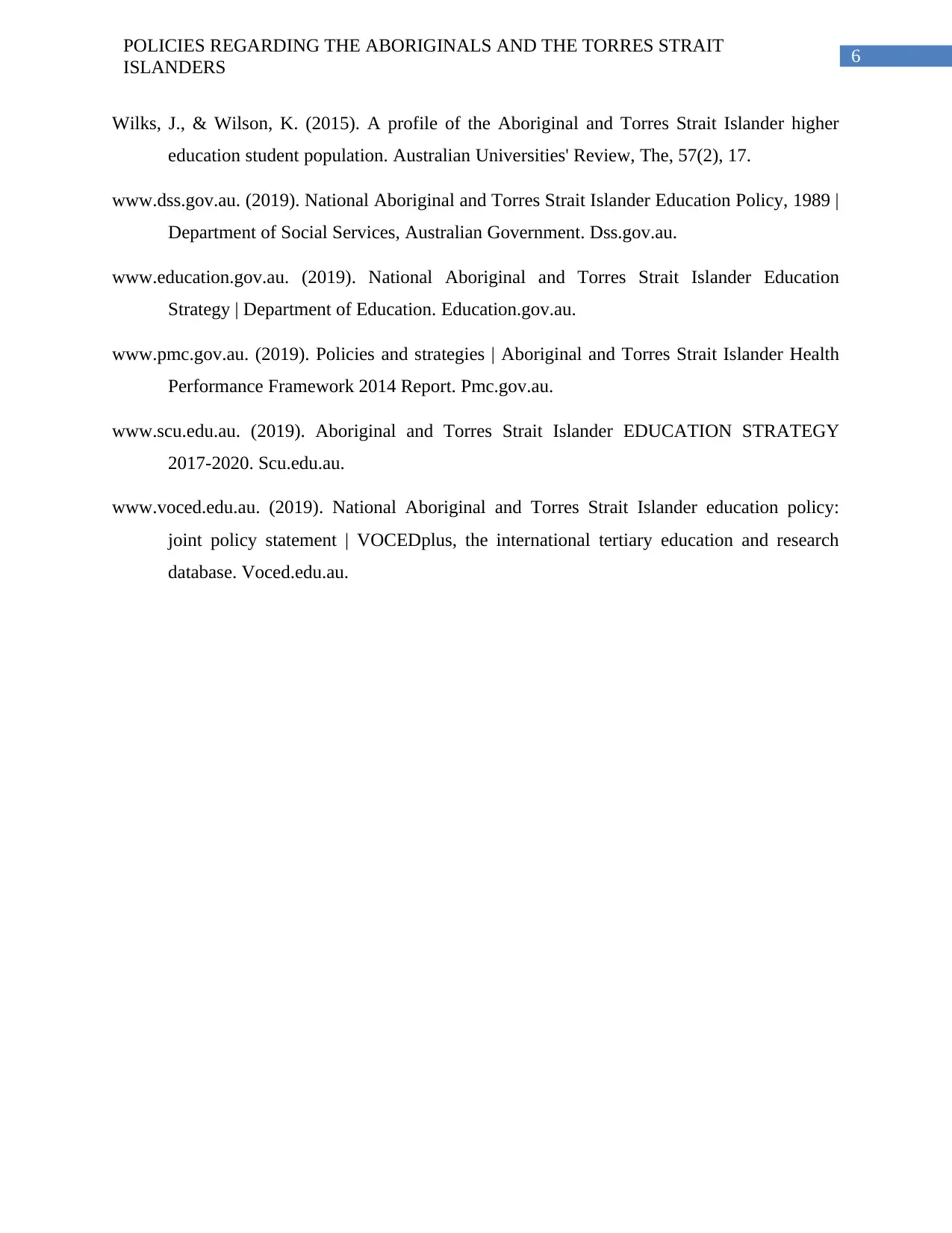
6
POLICIES REGARDING THE ABORIGINALS AND THE TORRES STRAIT
ISLANDERS
Wilks, J., & Wilson, K. (2015). A profile of the Aboriginal and Torres Strait Islander higher
education student population. Australian Universities' Review, The, 57(2), 17.
www.dss.gov.au. (2019). National Aboriginal and Torres Strait Islander Education Policy, 1989 |
Department of Social Services, Australian Government. Dss.gov.au.
www.education.gov.au. (2019). National Aboriginal and Torres Strait Islander Education
Strategy | Department of Education. Education.gov.au.
www.pmc.gov.au. (2019). Policies and strategies | Aboriginal and Torres Strait Islander Health
Performance Framework 2014 Report. Pmc.gov.au.
www.scu.edu.au. (2019). Aboriginal and Torres Strait Islander EDUCATION STRATEGY
2017-2020. Scu.edu.au.
www.voced.edu.au. (2019). National Aboriginal and Torres Strait Islander education policy:
joint policy statement | VOCEDplus, the international tertiary education and research
database. Voced.edu.au.
POLICIES REGARDING THE ABORIGINALS AND THE TORRES STRAIT
ISLANDERS
Wilks, J., & Wilson, K. (2015). A profile of the Aboriginal and Torres Strait Islander higher
education student population. Australian Universities' Review, The, 57(2), 17.
www.dss.gov.au. (2019). National Aboriginal and Torres Strait Islander Education Policy, 1989 |
Department of Social Services, Australian Government. Dss.gov.au.
www.education.gov.au. (2019). National Aboriginal and Torres Strait Islander Education
Strategy | Department of Education. Education.gov.au.
www.pmc.gov.au. (2019). Policies and strategies | Aboriginal and Torres Strait Islander Health
Performance Framework 2014 Report. Pmc.gov.au.
www.scu.edu.au. (2019). Aboriginal and Torres Strait Islander EDUCATION STRATEGY
2017-2020. Scu.edu.au.
www.voced.edu.au. (2019). National Aboriginal and Torres Strait Islander education policy:
joint policy statement | VOCEDplus, the international tertiary education and research
database. Voced.edu.au.
1 out of 7
Related Documents
Your All-in-One AI-Powered Toolkit for Academic Success.
+13062052269
info@desklib.com
Available 24*7 on WhatsApp / Email
![[object Object]](/_next/static/media/star-bottom.7253800d.svg)
Unlock your academic potential
Copyright © 2020–2025 A2Z Services. All Rights Reserved. Developed and managed by ZUCOL.





